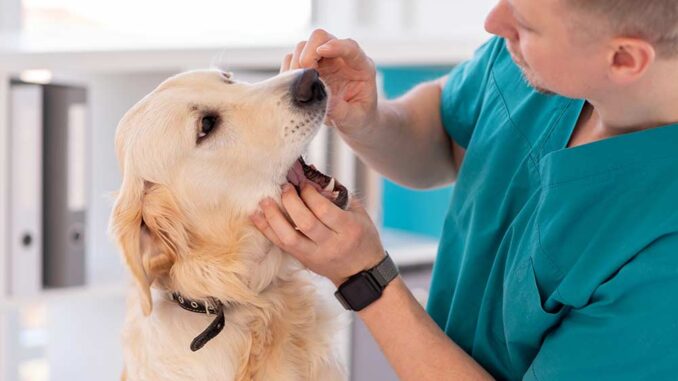
This article was updated on August 13th, 2023
Most dogs will encounter some dental issues at some point in their life and, in my experience, they are easily missed by even the most dedicated owner. Signs can be subtle and there is a misconception that all dogs have bad breath and that older dogs should lose teeth.
Studies have shown that well over half of dogs will have dental disease by the time they have reached their third birthday (1). Given the volume of dental disease I see each day, this sounds about right. By the time the dog is middle-aged, untreated dental disease can be quite severe and can really impact on a dog’s quality of life.
What should your dog’s teeth and gums looks like?
A healthy mouth contains pale pink gums that are firmly attached to pearly white teeth. The teeth should be well aligned and not coated in calculus. There should not be any gum inflammation, swelling or redness. Any halitosis (bad breath) should be minimal and will generally be linked to a recent strong-smelling meal.
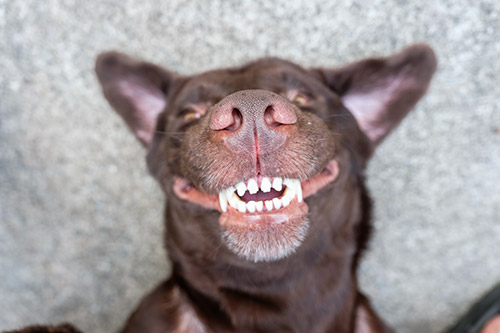
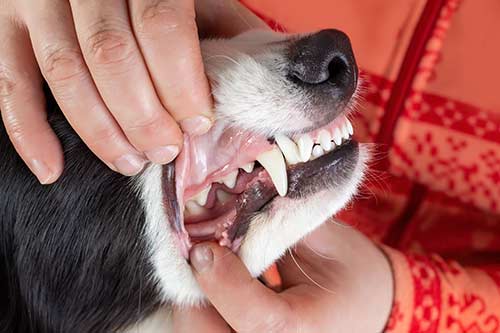
What teeth problems look like in dogs (with pictures)
Gingivitis
This is gum inflammation which can be seen as a redness above the teeth and/or a swelling of the adjacent gum tissue. Severe gingivitis will lead to oral bleeding when your dog is playing with toys or eating.
The main triggers for canine gingivitis are genetics, poor dental hygiene and a soft food diet. A build up of bacteria between the tooth and gumline causes the gum to inflame.
Minor gingivitis can be treated with daily tooth brushing and plaque dissolving products.
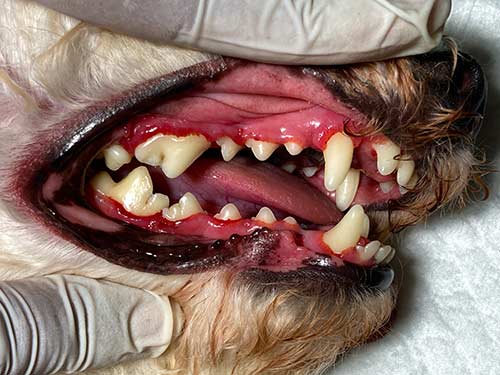
Calculus
Calculus is a brown or yellow build up on the surface of the teeth composed of mineralized inorganic material. The rough surface is the ideal home for more bacteria to multiply.
Calculus may be cracked off during tooth brushing or when a dog eats hard kibble or a dental stick, but most dogs will need a dental cleaning to resolve the issue.
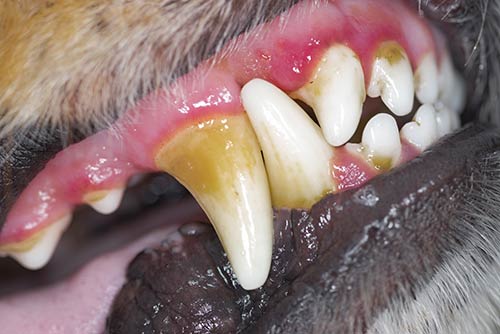
Advanced periodontal disease
A common issue we see in clinical practice, many dogs suffer with a combination of gingivitis, calculus build up, bad breath and oral pain. At this point, no at home care can reverse the changes and a dental under anesthetic is required.
Delaying the dental is not advised as this will worsen the periodontal disease and can even lead to bacteria spreading around the body.
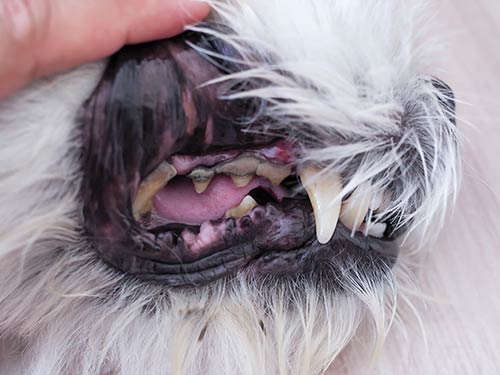
Oral abscess
Those who have ongoing dental disease and a large bacterial burden in their mouth may go on to develop an oral abscess. I tend to see these occurring more often in smaller breeds such as Chihuahua and Jack Russells. They can present as a small hole in the cheek that leaks fluid.
An abscess tells us there is a rotten tooth, which will usually need extracting so the pus can drain. Your vet will also issue you with some antibiotics and pain relief.
From home, we can soothe the area by applying warm compresses to the swelling, which may help draw out some infection. As eating will be sore, feed your dog soft food until recovered. See this picture of facial swelling in a dog (on MyPetsDentist.com).
Retained deciduous teeth
By about 7 months of age, your pup should have lost all of their baby teeth. In some cases however, this does not happen. Breeds like the Chihuahua, Shih Tzu and Cavapoo are more likely to experience the issue. If they have not all fallen out by 6-7 months of age, do lots of ‘tug toy’ games with your dog to see if this helps shift them.
If the teeth do not fall out, they should be surgically removed. This is because a retained tooth tends to lead to plaque build up and localized gingivitis, Many owners combine this procedure with neutering.
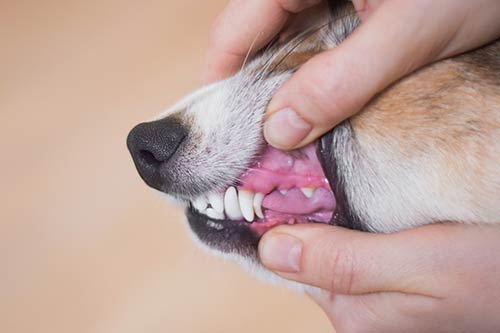
Fracture
Much like bones, teeth can fracture. This can occur after e.g. chewing a stone or bone, or trauma to the head. The fracture can cause pain when eating and may lead to an infection. It is always something we want to bring to the attention of the local vet ASAP. Most of the time a broken tooth will be extracted, but a root canal may be an option for some.
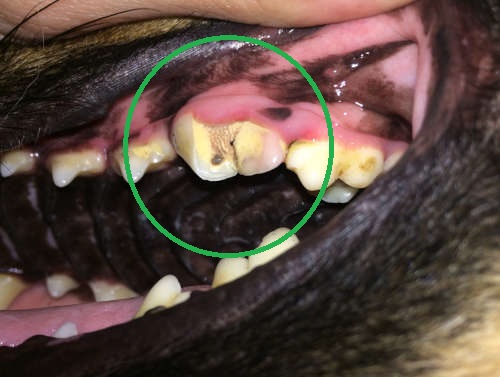
Steps you can take at home to help your dog with teeth problems
There are plenty of things we can do at home to both prevent dental disease and to manage mild gingivitis.
This would include:
- Feeding a hard kibble, which can be a dental diet. Harder foods do not cake as much on the teeth (2), leading to less plaque and calculus build up. Chews and dental sticks also work well to fend off plaque.
- Using plaque reducing products such as powders or gels. Depending on the product, this may be rubbed on gums, added to food or given in water.
- Daily tooth brushing. This is certainly the best way of staving off dental disease and is something owners should try and introduce during puppyhood, so the pup just sees it as part of normal life. We can use doggy toothbrushes or finger brushes alongside flavored tooth paste. Human toothpaste should never be given and can be toxic.
- FOR DOGS AND CATS: Enzymatic toothpaste specifically formulated using an enzyme system for dogs and cats to reduce plaque, freshen breath, and ensure a clean mouth. Poultry flavor pets love
- 🐾 VERSATILE CLEANING KIT - The BOSHEL 8 Pc Finger Toothbrush for Dogs includes 6 silicone bristle and 2 nylon bristle toothbrushes, ensuring a suitable tool for every pet's dental care needs, from puppies to large breeds.
When to call your veterinarian
If you’ve noticed any signs of dental disease, a retained tooth or a fractured tooth it is time to call your vet. With dental issues, the earlier on we treat the issue, the less it can progress and the less we need to intervene. Waiting until dental disease is advanced can mean we have no choice but to extract a large number of teeth.
Treatment options and likely costs
For very mild gingivitis, your vet may simply recommend a diet change and daily tooth brushing. This new food may not cost any more than your dog’s old diet and tooth brushing is very inexpensive.
The cost of a dental treatment can range anywhere from $250-$1,200 and depends on the size of your pet and the number of teeth which need to be removed, as well as the amount of dental x-rays that are taken.
Frequently Asked Questions
How often should I brush my dog’s teeth?
You may not want to hear this, but ideally every day! A minimum of 2-3 times a week is recommended, but we should be aiming for daily.
What are some dental treats that can help with oral hygiene? Do they work?
Treats like Greenies and Dental sticks can work to eliminate food that is stuck on teeth and prevent calculus build up.
At what age should I start caring for my puppy’s dental health?
Get your pup used to having a finger or toothbrush in their mouth from early on. While we don’t want to vigorously brush their teeth while they are teething (this can cause discomfort), we do want them to know that tooth brushing is normal and nothing to be scared of.
Is anesthesia safe for my dog during dental procedures?
Anesthesia is generally very safe. It saddens me when an owner insists their senior dog cannot have a dental as they’re worried about the anesthetic. Unless a dog has serious underlying health issues, getting the dental done is almost always the best option for the pet.
- https://www.researchgate.net/publication/23259333_Periodontal_disease_in_research_beagle_dogs_-_an_epidemiological_study
- https://onlinelibrary.wiley.com/doi/abs/10.1111/j.1751-0813.1994.tb00905.x
Disclaimer: This website's content is not a substitute for veterinary care. Always consult with your veterinarian for healthcare decisions. Read More.





Be the first to comment